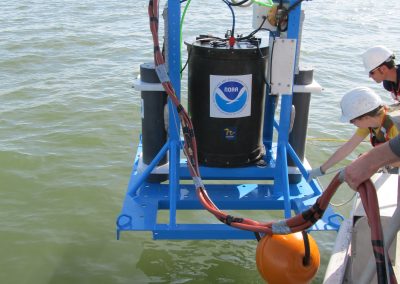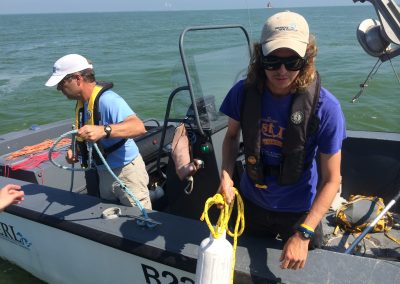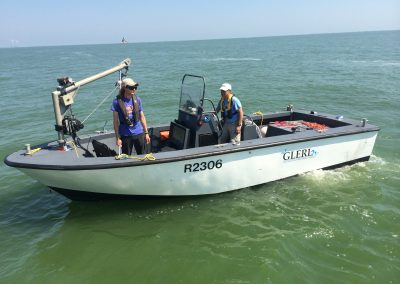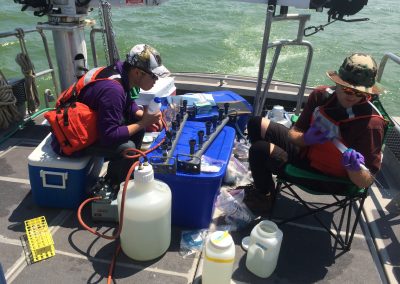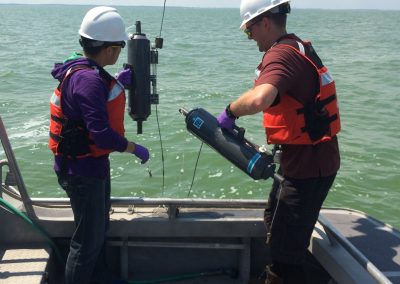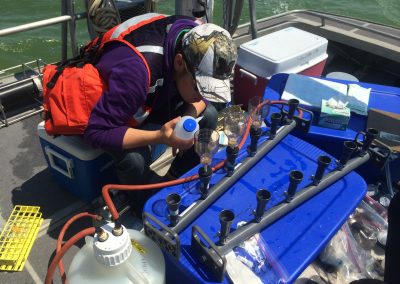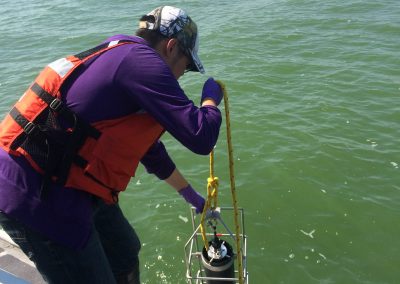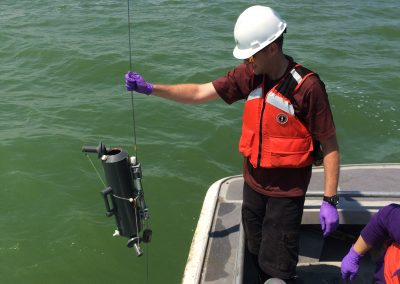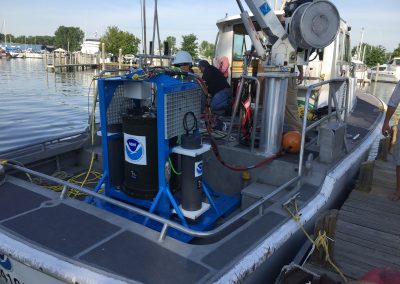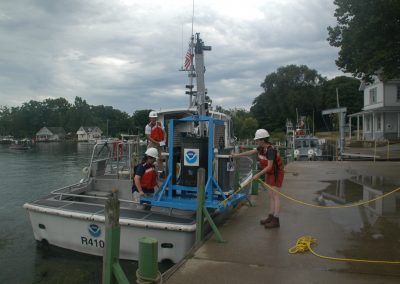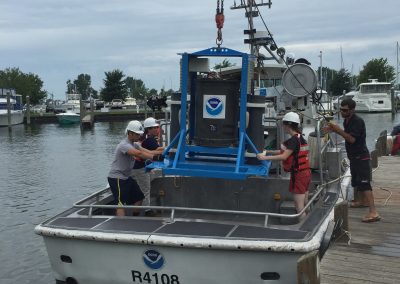Ecological Risk Assessment
HABs, Bacteria, and Beach Quality Forecasting for the Great Lakes Ocean and Human Health Center
HABs Monitoring, Forecasting and Genomics for the Great Lakes
1. Develop an improved nowcast-forecast model for Lake Erie harmful algal blooms (HABs) that shows the spatial extent of the bloom in near real-time and predicts transport of the bloom over a five-day forecast period.
2. Monitor the environmental conditions, extent, and toxicity of Microcystis blooms in Lake Erie and Saginaw Bay.
HABS Outreach and Research to Users Program
The goal of this sub-project is to assess public health, drinking water quality and natural resource managers’ and decision-makers’ research and information needs in order to improve harmful algal blooms research development and forecasts, to ensure successful technology transfer. Developing user friendly, timely products, tools and services requires stakeholder involvement in determining research priorities and providing stakeholders with research materials that are translated into a concise, easily understood formats to assist in local decision-making and education. The objectives of this work are to identify and assess user needs (related to harmful algal blooms) and disseminate scientific information, technology, and research materials to aid health officials, local governments, and communities in making sound environmental decisions.
Near-Real Time, In situ, Microcystin Detection using the ESPniagara
The goal of the Environmental Sample Processor (ESP) sub-project is to focus on developing the ability to detect and quantify cyanotoxins in situ, in near-real time. The ESP is a robotic, electromechanical instrument capable of acquiring, processing, and analyzing samples for molecular-based detection and measurement of organisms and their metabolites (e.g., toxins) in situ, in near real-time. Although the ESP has been deployed numerous times in marine coastal waters, this technology has not been utilized in freshwater systems to monitor potentially toxic cyanobacteria and their toxins until summer 2016. Since late 2015 CILER and NOAA scientists have been making the necessary scientific and engineering advancements to adapt this ocean technology for use in Lake Erie.
Publications
Rowe, M. D., E. J. Anderson, T. T. Wynne, R. P. Stumpf, D. L. Fanslow, K. Kijanka, H. A. Vanderploeg, J. R. Strickler, and T. W. Davis (2016), Vertical distribution of buoyant Microcystis blooms in a Lagrangian particle tracking model for short-term forecasts in Lake Erie, J. Geophys. Res.: Oceans, 121, doi:10.1002/2016JC011720.
Reavie, E. D., Cai, M., Twiss, M. R., Carrick, M. R., Davis, T. W., Johengen, T. H., Gossiaux, D., Smith, D. E., Palladino, D., Burtner, A., & Sgro, G. V. Winter–spring diatom production in Lake Erie is an important driver of summer hypoxia. (2016). Journal of Great Lakes Research, 42(3), 608-618.
Stumpf, R. P., Davis, T. W., Wynne, T. T., Graham, J. L., Loftin, K. A., Johengen, T. H., Gossiaux, D., Palladino, D., & Burtner, A. M. (2016). Challenges for mapping cyanotoxin patterns from remote sensing of cyanobacteria. Harmful Algae, 54, 160-173.
Gobler, C.J., J.M. Burkholder, T.W. Davis, M.J. Harke, T. Johengen, C.A. Stow, D.B. Van de Waal (2016). The dual role of nitrogen supply in controlling the growth and toxicity of cyanobacterial blooms. Harmful Algae 54 (2016) 87-97.
Cory, R.M., T.W. Davis, G.J. Dick, T.H. Johengen, V.J. Denef, M. Berry, S.E. Page, S.B. Watson, K. Yuhas, G.W. Kling (2016). Seasonal dynamics in dissolved organic matter, hydrogen peroxide, and cyanobacterial blooms in Lake Erie. Frontiers in Marine Science, vol3, Article 54.
Presentations
M. D. Rowe, E. J. Anderson, T. T. Wynne, R. P. Stumpf, D.L. Fanslow, H. A. Vanderploeg, Advection and vertical distribution of buoyant cyanobacterial colonies in a Lagrangian particle model for short-term forecasts of harmful algal blooms in Lake Erie, American Geophysical Union Ocean Sciences Meeting, 21-26 February, 2016, New Orleans, LA.
M. D. Rowe, Influence of tributary nutrient loads and quagga mussels on nearshore and offshore distributions of chlorophyll and nutrients in a Lake Michigan FVCOM biophysical model, State of Knowledge of Cladophora in the Great Lakes Workshop, January 26-28, 2016, Ann Arbor, MI (invited).
M. D. Rowe, E. J. Anderson , T. T. Wynne, R. P. Stumpf, D. L. Fanslow, H. A. Vanderploeg, Simulation of the vertical distribution of buoyant Microcystis colonies in an FVCOM offline Lagrangian particle model for short-term forecasts of harmful algal blooms in Lake Erie, FVCOM User’s Workshop, October 20-22, 2015, Bedford Institute of Oceanography, Dartmouth, Nova Scotia.
M. D. Rowe, E. J. Anderson, D. L. Fanslow, H. A. Vanderploeg, Development of the FVCOM Lagrangian particle trajectory model for 3D HAB transport and forecasting in Lake Erie, NOAA FVCOM Workshop, September 3, 2015, Silver Spring, MD (invited).
M. D. Rowe, E. J. Anderson, A. J. Vander Woude, T. H. Johengen, H. A. Vanderploeg, Vertical mixing and buoyancy in a model for short-term forecasts of cyanobacterial HABs in Lake Erie, International Association of Great Lakes Research annual meeting, May 29, 2015, Burlington, VT.
JOHENGEN, T.H., Palladino, D., Miller, R., Stuart, D., Purcell, H., Ruberg, S.A. Continuous Water Quality Monitoring to Understand Drivers of Harmful Algal Bloom in Lake Erie. ASLO Conference, June 2016, Santa Fe, NM.
Palladino1, D., Johengen1, T.H., Ruberg2, S.A., Miller1, R., Purcell1, H.L., Stuart1, D. Burtner1, A.M. What’s really been going on: A retrospective look at algal blooms in western Lake Erie using in situ sensors. ASLO Conference, June 2016, Santa Fe, NM.
JOSHI, S.J. NOAA’s Harmful Algal Bloom Forecasting Products. North Central Region Water Network. Water Currents Webinar. July 15, 2015 (2015)
JOSHI, S. Algal Blooms in Michigan: Monitoring and Prediction and Overview. Southeast Michigan Environmental Health Association Annual Meeting. Livonia, MI, September 18, 2015 (2015)
JOSHI, S. Lake Erie/ Lake St. Clair Citizen Fisheries Advisory Committee presentation on HABs. Belle Isle, MI. October 6, 2015 (FY16).
ANDERSON, E. J., T.W. DAVIS, S.A. RUBERG, M.D. ROWE, A.J. VANDER WOUDE, JOSHI, S* (presented on behalf of Eric Anderson) Coastal Estuarine Research Federation Conference. November 11, 2015 (FY16).
JOSHI, S. Identifying and Assessing Needs of Management Community. HABs Collaboratory Inaugural Meeting. December 15, 2015. JOSHI, S. Harmful Algal Blooms- NOAA’s Monitoring and Prediction. The Stewardship Network Monthly Webcast. January 8, 2016.
JOSHI, S. The Great Lakes and Your Health. Saline Rotary Club Meeting. January 28, 2016. JOSHI, S. Harmful Algal Blooms: NOAA’s Monitoring and Prediction. Harmful Algal Blooms: A Public Safety Forum hosted by the Stewardship Network Western Lake Erie Cluster. March 10, 2016.
JOSHI, S.J. NOAA’s Harmful Algal Blooms Forecasting Tools. 2016 Western Lake Erie/ Detroit River Regional Michigan Sea Grant Fisheries Workshop. Taylor, MI, April 21, 2016.
JOSHI, S.J., T. JOHENGEN, E.J. ANDERSON. NOAA GLERL’s HABs Program: Regional Example. NOAA Annual Ecological Forecasting Roadmap Meeting. College Park, MD, April 27, 2016.
Mikulski, C., A. Ritzenthaler, S. Ruberg, T. Davis, and G. Doucette. Development of an immunoassay for autonomous, subsurface detection of particulate microcystins in Lake Erie. 8th Symposia on Harmful Algae in the U.S., Long Beach, CA, November 15-19, 2015.
Davis, T., A. Burtner, D. Palladino, A. Ritzenthaler, D. Gossiaux, S. Ruberg, T. Johengen. Introduction to NOAA GLERL’s Harmful Algal Bloom Monitoring Program. Invited Presentation, McLane Laboratories, December 2015.
Products
• Project website: http://www.glerl.noaa.gov/res/HABs_and_Hypoxia/esp.html
• A new version of the short-term HAB forecast (HAB Tracker) was created(www.glerl.noaa.gov/res/HABs_and_Hypoxia/habTracker.html).
PrincipaI Investigator(s):
Tom Johengen (CILER)
Mark Rowe (CILER)
NOAA Technical Lead(s):
Tim Davis (NOAA-GLERL)
Eric Anderson (NOAA-GLERL)
The ESPniagara being lowered into Lake Erie for its first test deployment. This is the first ESP to be deployed in the Great Lakes. Photo Courtesy of NOAA.
Dack Stuart (CIGLR) and Russ Miller (CIGLR) sampling during a harmful algal bloom event. Sampling cruises are completed weekly during bloom season to collect water samples, deploy marine instrumentation (SeaBird CTD, fluoroprobe) and collect hyperspectral measurements using digital imaging and light intensity. Photo Courtesy of NOAA.
Dack Stuart (CIGLR) and Russ Miller (CIGLR) working and preparing sampling equipment for HABs sample collection. Photo Credit: NOAA.
Former masters student Tonghui Ming and former CIGLR postdoc Kevin Meyer processing samples. Dr. Meyer used these samples to better understand the impact of HABs on the Great Lakes and surrounding communities. Photo Credit: NOAA.
Former Masters student Tonghui Ming and former CIGLR postdoc Kevin Meyer sampling water using Niskin bottles during a harmful algal bloom event. Dr. Meyer was studying freshwater HABs (mostly cyanobacteria) in the Great Lakes using a variety of genetic and bioinformatic tools. His research interests and goals were to better understand the drivers of bloom formation, termination, and toxicity so that innovative and effective management strategies can be implemented to reduce the impact of HABs on the Great Lakes and surrounding communities. Photo Credit: NOAA.
Former SNRE masters student Tonghui Ming collecting water quality data. This data helped tell the researchers more about harmful algal bloom characteristics. Photo Credit: NOAA.
Former CIGLR postdoc Kevin Meyer collecting water samples using a Niskin bottle. The team was out sampling the water during a harmful algal bloom event. Photo Credit: NOAA.

